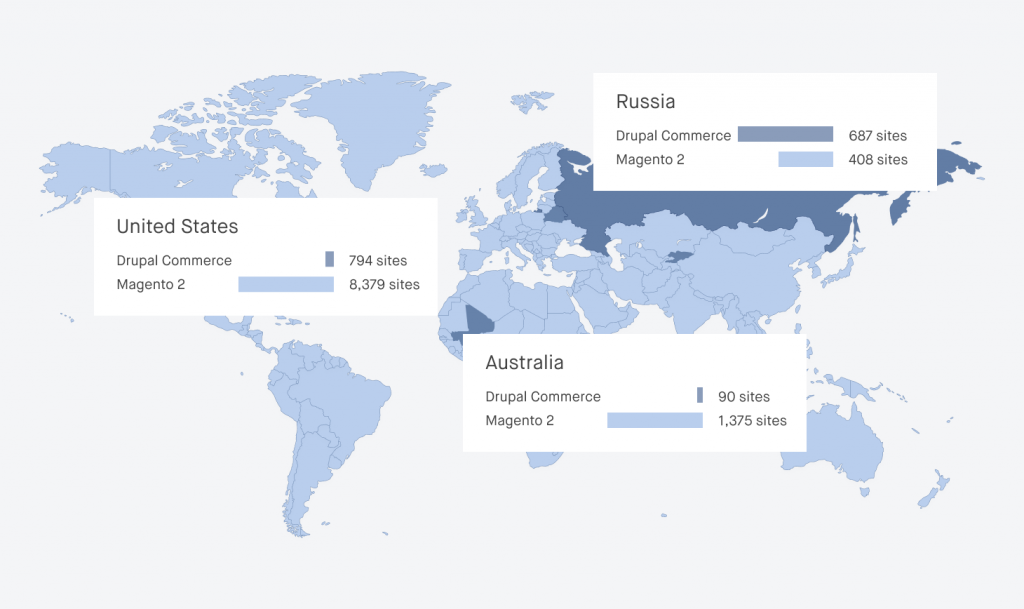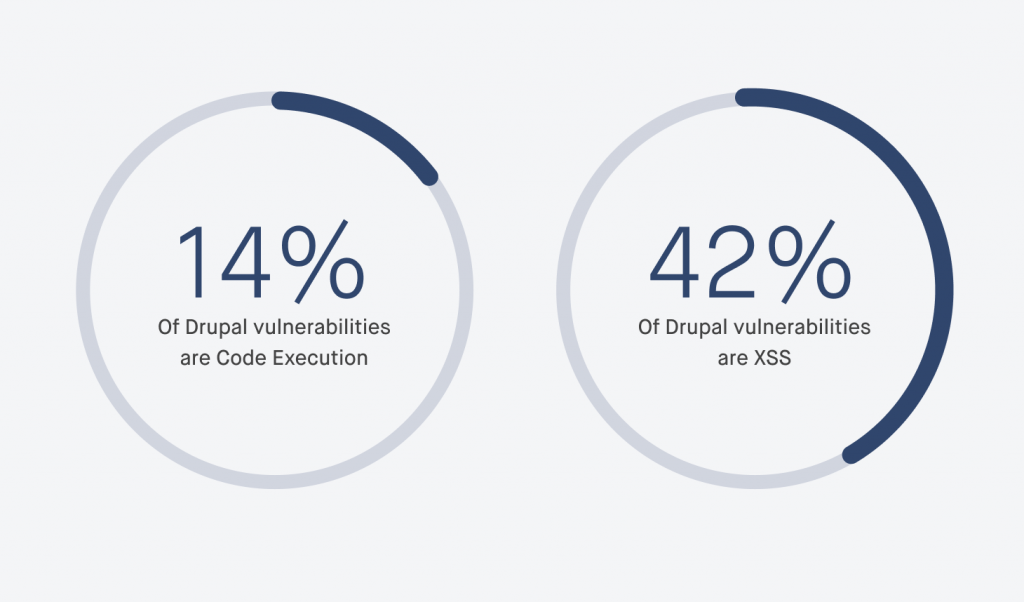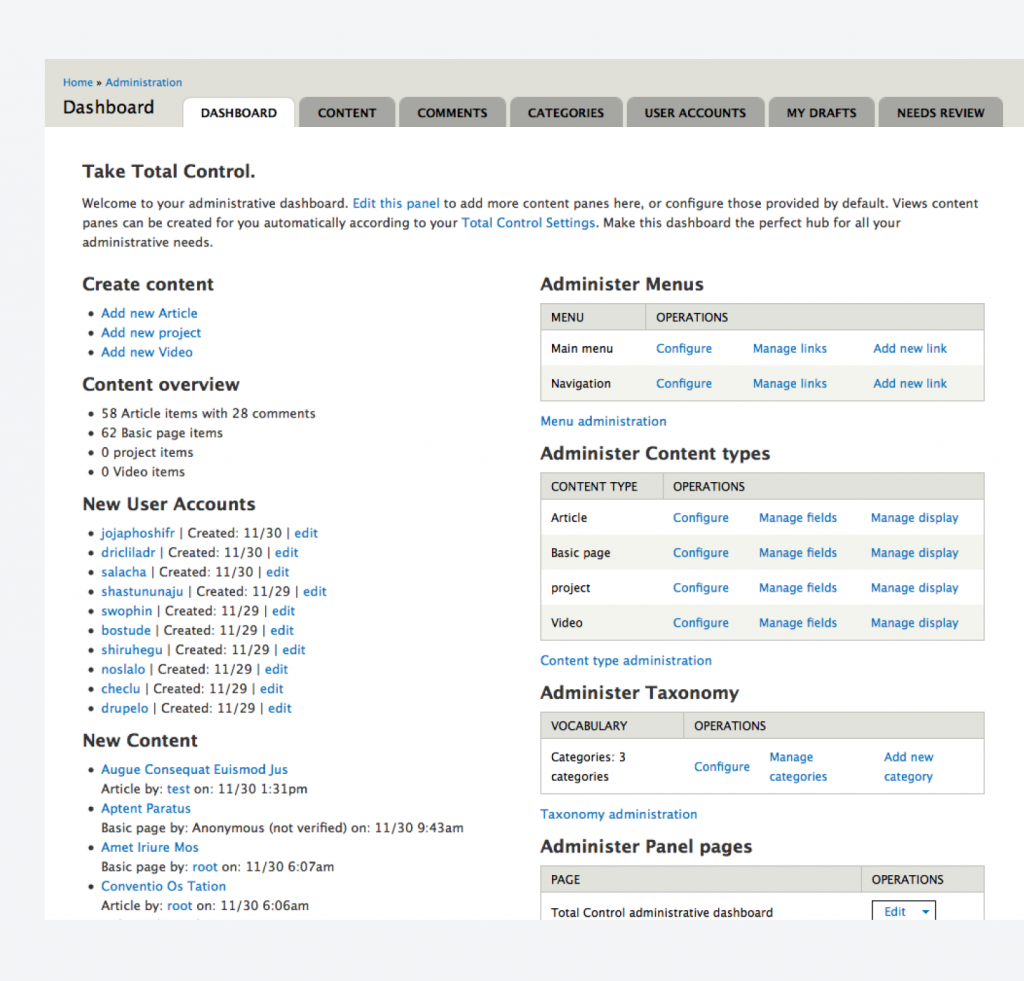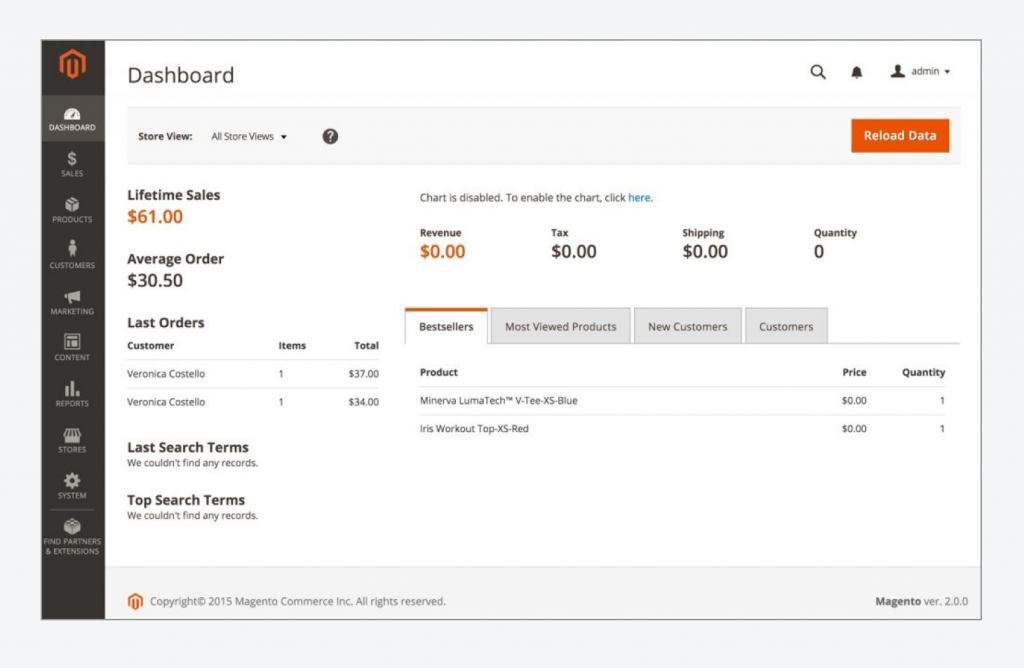The battle of Drupal Commerce vs Magento 2 is getting tense lately. Being a relatively new platform, Drupal Commerce is attracting merchants with its regular updates, recently announcing the release of Drupal 9 / Commerce 2.0. Adobe Commerce (formerly Magento 2) doesn’t lag behind and retains merchants with secure web tools and unique customer experience.
In their Magento vs Drupal statistics, SimilarTech stresses different market shares of the two platforms. About 11% of Magento active websites are based in the US, while Drupal Commerce is favored more in East Europe and Russia.

But how does one choose between Magento and Drupal Commerce? Is one better than the other?
Having operated for 13+ years in the ecommerce development industry at Elogic, we’ve helped hundreds of brands find the perfect ecommerce platform for their business needs.
Read further to find the basic features of Drupal Commerce vs Magento 2 as well as the ideal customer profile for each of the platforms.
Disclaimer: Drupal is primarily a content management system (CMS), but we will be focusing on the Drupal ecommerce module in this article. To avoid confusion, Drupal vs Magento 2 will be compared against the backdrop of their ecommerce functionalities.
Drupal Commerce vs Magento 2 Basic Overview
Here are the basic characteristics of Drupal vs Magento in a table.
| Adobe Commerce (formerly Magento 2) | Drupal | |
| Ease of use | Complex | Complex |
| Source code accessible | Open-source | Open-source |
| Hosting | On-site, third-party, Cloud-based | On-site, third-party, Cloud-based |
| Extensions | 5,500 + | 46,000 + |
| Cost | $50-$250/hr + free access to code (open source) for Magento Open Source Edition (Community)or $22,000+/year for Magento Commerce Edition (Enterprise)or $40,000+/year for Magento Cloud Edition | $61-80/hr developers rate + free access to code (open source) |
| Features | Feature-rich | Feature-rich |
| Ease of Integration | Flexible | Flexible |
| Theme selection | 12 | 3,000+ |
| Payment Gateways | Support of 12 payment gateways | Support of 114 payment gateways |
| Security | Built-in security patches, but subject to many ransom & DDOS attacks | Built-in security updates that last for years |
| Scalability | Scalable | Scalable |
| Multilingual capabilities | Built-in multi-lingual support | Built-in multi-lingual support (112 translation groups) |
| SEO | Built-in SEO tools, customizable plug-ins and apps | Customizable plug-ins (modules) |
| Available Devices | Windows, Android, iPhone/iPad, Mac, Web-based | Windows, Android, iPhone/iPad, Mac, Web-based |
| Ideal Ecommerce Size | A large enterprise with lots of resources | SMEs with complex, content-heavy, and high-traffic websites who seek customization |
Drupal Commerce is an open-source eCommerce software that augments the Drupal content management system. Some basic things you should know about Drupal Commerce are that it is:
- initially intended for content management and publication;
- extremely flexible and configurable for selling non-traditional products (for instance, subscription type of content, news, or e-books);
- ideal for any business seeking unique checkout flow and custom attributes.
Drupal market share: Drupal has a 1.9% market share among content management systems, while its commerce solution powers 1.2% of online retailers’ websites.
When comparing Magento vs Drupal, the latter might seem like a little inexperienced brother. Still, even though it’s a relatively new platform, Drupal Commerce has already won the trust of such retailers as Pfizer, Lush, and Vipp.
Adobe Commerce (Magento) is an ecommerce platform written in PHP which is available in three versions: Magento Open Source, Magento Commerce, and Magento Commerce Cloud. The latter two have been recently merged under the name of Adobe Commerce and come at a license fee.
Unlike Drupal, Magento has been developed specifically for ecommerce activities, is easy to customize, and allows selling all types of products. Its basic features are the following:
- developed specifically for carrying out ecommerce tasks, including inventory management and marketing;
- Magento’s customizability and scalability;
- ideal for businesses working in retail and wholesale of both traditional and digital products (anything from beauty niche to electronics).
Magento Commerce market share: Magento powers 165,093 ecommerce websites, holding a market share of 1.8%.
Powered by Adobe, Magento stands among the leading commerce platforms offering solutions for big retailers and famous brands, like Ford, Rovio, and Nike.
Before we dive into details, we have three amazing articles on how Magento (compares to Shopify, WooCommerce, and BigCommerce.
Magento vs Drupal Commerce Review in Details
If Drupal and Magento equally got your attention, a short overview isn’t enough. Drupal Commerce and Magento 2 have their similarities and differences which go far beyond the price and their way of use.
Read on to learn about the pros and cons of each ecommerce platform.
Price/Costs
For both Magento and Drupal, you have to take into account the expenses for hiring a team of developers who will get your project up and running.
Developers’ hourly rate depends on their experience and location, as well as on the scale and scope of your project. Freelance Drupal developer rates worldwide vary from $61-80/hr, and the hourly rate for Magento developers can be anywhere from $50-$250/hr.
Read more: How Much Ecommerce Website Costs: Set the Right Budget for Your Project
Drupal Commerce is a developer-oriented platform where the technical cost of entry is free. You get access to the code free of charge but will pay for third-party applications and extensions requiring a license.
Adobe Commerce (Magento) offers three editions, all at varying pricing.
- Magento Open Source Edition (Community) comes free of charge, but the merchant will have to pay any maintenance, security, design, and hosting fees.
- Adobe Commerce (formerly Magento Commerce/Enterprise Edition) costs $22,000+ annually depending on how advanced you want your e-store features to be.
- Adobe Commerce Cloud sells for a striking $40,000+ per year, but includes a hosted cloud, DDOS protection, and everything a merchant might need for website security.

Eventually, the costs for both Drupal Commerce and Magento projects even up. Even though Drupal Commerce might seem like a cheaper option, a merchant would have to spend on paid add-ons to customize their store. Magento isn’t that expensive either: its open-source free edition is flexible enough to meet one’s business needs.
The choice of Drupal Commerce vs Magento 2 narrows down to the purpose of the business rather than the costs.
Features
Oftentimes ecommerce owners choose a platform based on the list of features that satisfy one’s business needs. Let’s see who wins in the feature category in this guide: Magento or Drupal.
Drupal Commerce has eight state-of-the-art feature sets that scale from simple to complex and, according to the official website, are highly secure. The core feature sets mostly center around content creation and include the following:
- Content as a Service (various content layouts and scaling, content optimization and customization for authors and editors)
- Security (user access control, database encryption, mitigation of DoS attacks)
- Performance & Scaling (more than a million checks a day for potential performance issues)
- Multilingual (more than 100 languages immediately available in Drupal)
- Accessibility (editorial options to enforce accessible content creation)
- Marketing Automation (real-time sales alerts, advanced email reporting for specific audiences)
- Content Authoring (multi-user content creation in one place)
- Personalization (A/B and multivariate testing)
One thing you should know about Drupal Commerce though is that it isn’t an out-of-the-box solution. All the abovementioned features should be installed as modules contributed by the developers’ community or built from scratch.
Adobe Commerce feature sets are more advanced and versatile, especially when it comes to sales and marketing. The platform offers a wide variety of out-of-the-box general features available for both paid and free editions of Magento Commerce:
- Marketing, promotions, and conversion tool (good for upselling and cross-selling)
- Site management
- Search Engine Optimization (SEO)
- Catalog management
- Product browsing (create wish lists, check stock availability, share on social media)
- Catalog browsing
- Checkout, payment, and shipping
- Order management
- Customer accounts
- Customer service
- International support
- Analytics and reporting
- Mobile commerce
Besides, Adobe Commerce integrates B2B functionalities, like an easy-to-use customer portal, multiple tiers of buyers with specific roles and permissions, quotes and orders, among others, which Drupal Commerce doesn’t have. So if you run a more complex business model and are interested in more advanced sales and marketing features, the choice of Magento should be a no-brainer.
Hosting
Both platforms have strict requirements for hosting. Specifically, you need productive servers that will sustain content-heavy, high-traffic websites.
To run and install Drupal ecommerce hosting, you should use a host with an increased PHP memory limit since such websites usually require more horsepower than average. Drupal Marketplace recommends a number of trusted server providers at a price range from $2.95/month at Bluehost to $114/month at Pantheon.
Adobe Commerce can be hosted on-site, in the cloud, or through a third party. A merchant may choose Magento Commerce Cloud to fully host and run a website by Magento or host the e-store with a different provider. Magento ecommerce hosting cost varies from $2.75 at HostGator to $19.95 at Nexcess.
Theme selection
Drupal Commerce offers almost 3,000 themes, many of which are contributions of other users to the website. You can also create your own theme and share it with the community using Download & Extend.

Ever since Magento rebranded into Adobe Commerce, the vendor started narrowing down on pre-built themes and prioritizing the custom ones. You can download multiple Templates Masters off the official marketplace that will serve as a basis for your own theme. You can also find community-created themes on websites like TemplateMonster or ThemeForest or create your own custom solution with ecommerce web design services.

SEO
In Drupal Commerce, SEO is performed with Drupal modules. Users can install modules from the corresponding category on the official website and, thus, integrate Google Analytics, meta-tag systems, robots.txt generators, and so on.
Adobe Commerce (Magento) is also extremely flexible in terms of technical SEO and allows customizing plug-ins. Magento 2 builds its SEO tools right into the ecommerce platform. A website owner can benefit from no-follow links, edit permalinks and meta tags, change URLs, and take technical Magento 2 SEO to the next level.
Extensions & Apps
For Drupal Commerce, 46.000+ extensions and modules can be downloaded from the corresponding directory on the website. For Magento, 3.500+ extensions can be found on Marketplace and smoothly integrated into the Magento back-end.
Both platforms integrate well with major social networks as well as Windows, Android, Mac, and web-based devices. However, one of the biggest advantages of Magento is that it integrates well with other major solutions of Adobe, including but not limited to Adobe Sensei for AI-powered personalization and search, Adobe Analytics with advanced business intelligence and reporting, and Customer Experience Management (CXM) perfect for Magento omnichannel commerce.
So if you’re looking to create outstanding customer experience for your big brand, Magento should be a better solution than Drupal Commerce.
Payment Options
Reliable payment gateways are a way to win the trust of your customers and ensure the money for your products is in your pocket. So an ecommerce platform should provide a selection of secure payment methods that are available all over the world.
Read more: Payment Gateway Comparison: Price and Fees
Drupal allows you to manage payments and orders through 114 different payment providers. These include Amazon Pay, PayPal, Stripe, Vantiv, Banca Intesa (see the full list here). The payment methods can be on-site or off-site and require the installation of the corresponding Drupal module.
Adobe Commerce (Magento) directly supports 12 multicurrency payment gateways secure and active around the globe. Apart from PayPal, Braintree, Klarna, and Stripe, among others, Magento 2 allows offline payments like Cash On Delivery, Payment on Account, or Bank Transfer. Magento Payments is also in place to prevent online payment frauds, onboard easier, and manage cash flow effectively.
Security
Security is important for any ecommerce business, especially since online frauds and DDOS attacks are getting more and more sophisticated these days.
The good news for Drupal Commerce merchants is that it is one of the safest, most secure platforms for ecommerce. Each major version of Drupal receives security updates that account for issues like injection, cross-site scripting (XSS), and cross-site request forgeries. Open-source software presents an advantage to developers who can install any security module and modify the code. A developer should be extremely careful with the code, though: about 42% of Drupal security vulnerabilities account for XSS issues and 14% are code execution problems.

Adobe Commerce (Magento) has significantly improved its security patches in the past years. It’s true that Magento 1 was vulnerable to DDoS attacks and had issues protecting customers’ data. However, Magento 2 has implemented many security measures, including strengthened hashing algorithms in password management or improved prevention of XSS attacks, among other built-in security features. Magento also releases regular security patches to address Magento website vulnerabilities.
Scalability
Most businesses are born with the idea to grow; and both Drupal and Magento are scalable enough to fulfill this ambition.
Read more: How to Sell Products Internationally Online in 5 Steps
With Drupal, it’s all simple: whenever you need to add new functionality or resources to your website, you integrate a module and a Drupal Plugin API. And there’s a module literally for everything. Drupal 8 and later versions API, like most modern web frameworks, can scale well to millions of users only if it’s optimized well. Server scaling is also possible if your server hardware has reached its limits and there’s nothing more to optimize on the website. Drupal has impressive multilingual capacities too: its 112 translation groups will also allow you to translate your website easily and grow your business internationally.
Adobe Commerce (Magento) offers a scalable and secure infrastructure as well. It allows adding up to 250,000 products to a catalog, using multiple statistical and reporting tools at the same time, and cache full pages without sacrificing website performance. Magento 2 also prevents you from dealing with endless tables and databases which grow along with your online store. You can surely dream big with Magento and not worry about your business scaling up and down.
Ease of Use
We hate to break it to you right away, but neither Drupal nor Magento will allow you to launch a website on your own. Unless you’re a tech geek yourself who fancies programming, configuring your online store will not be easy. Coding is an extensive part of both Drupal Commerce and Magento packages, so you might need to request Drupal Commerce development service or hire a team of Magento developers to configure your website.
Just drop us a message and get a certified developer to build your store
Hire Magento developers nowTo configure the Drupal Commerce store, you basically need to download the latest version of Drupal CMS and follow the steps outlined in Drupal User Guide. After the installation and configuration, all store activities and administrative tasks are displayed in a simple dashboard.

To install Adobe Commerce, you’ll need to download Magento files via Composer or via the Web Setup Wizard and follow the Adobe Commerce 2.4 User Guide for more details. Soon after the configuration, a user will get an intuitive dashboard with all the administrative tasks and store activities in the palm of their hand.

Because Drupal Commerce and Magento are both open source, any developer has access to the original PHP code and can change it based on the merchant’s needs and requirements. The difficulty of use is thus compensated by the ease of customization and full control over your online store.
What’s the Best Take for You?
We hate to disappoint you, but there’s no winner in this Drupal vs Magento ecommerce battle. Despite their similarities, Drupal Commerce and Magento 2 target different merchants.
The ideal merchant of Drupal Commerce is an SME that plans to sell complex products and/or heavy content on its website. Such merchants often look for unique ecommerce features and customized checkout. The platform fits well with government agencies, non-profit organizations, and foundation websites which are often overloaded with content, require a high degree of flexibility and security, and can’t afford to incur big maintenance costs.
Magento works best for medium to large enterprises that have huge product catalogs and expect high website traffic. It is an attractive option for businesses planning to scale in the future and seeking ways to customize e-store functionality and design.
Food for Thought: Magento 2 Drupal 8 Integration
Can’t choose between Drupal Commerce vs Magento? Don’t limit yourself, take both!
Despite being competitors on the market, these platforms can actually be companions with outstanding content features of Drupal and seamless product experience of Magento.
Magento 2 Drupal 8 integration will take your business to a whole new level leading to headless ecommerce. The front-end side of your store may run completely on Magento, and the user will be seeing product pages and recommendations as Magento store. Drupal will handle content on the back-end and personalize blogs, vlogs, product descriptions in one place.
Futureproof your store with ecommerce experts at Elogic
Learn more about headlessFAQs
What is Drupal Commerce?
Drupal is primarily a content management system, and Drupal Commerce is a module that enables online selling and shopping transactions for a business. It is open-source software allowing merchants to build any ecommerce functionality, like checkout, invoicing, order management, and others.
Which ecommerce platform is better: Adobe Commerce (Magento) or Drupal Commerce?
Both platforms offer high levels of flexibility but target different kinds of businesses. Drupal Commerce will be a perfect fit for content-heavy subscription-based websites, which may not necessarily run ecommerce operations. Meanwhile, Adobe Commerce supports different business models (B2C, B2B, DTC, wholesale, manufacturing, etc.) and brings a much richer feature set to follow the latest ecommerce trends, like personalized customer experience or AI-powered search and analytics.
Is Magento used for ecommerce website development only?
Adobe Commerce (Magento) is used for ecommerce website development only. Meanwhile, Drupal is considered primarily a CMS with a separate Drupal ecommerce module and so may not necessarily be used by online retailers only.
FAQs
What is Drupal Commerce?
Drupal is primarily a content management system, and Drupal Commerce is a module that enables online selling and shopping transactions for a business. It is open-source software allowing merchants to build any ecommerce functionality, like checkout, invoicing, order management, and others.
Which ecommerce platform is better: Adobe Commerce (Magento) or Drupal Commerce?
Both platforms offer high levels of flexibility but target different kinds of businesses. Drupal Commerce will be a perfect fit for content-heavy subscription-based websites, which may not necessarily run ecommerce operations. Meanwhile, Adobe Commerce supports different business models (B2C, B2B, DTC, wholesale, manufacturing, etc.) and brings a much richer feature set to follow the latest ecommerce trends, like personalized customer experience or AI-powered search and analytics.
Is Magento used for ecommerce website development only?
Adobe Commerce (Magento) is used for ecommerce website development only. Meanwhile, Drupal is considered primarily a CMS with a separate Drupal ecommerce module and so may not necessarily be used by online retailers only.

